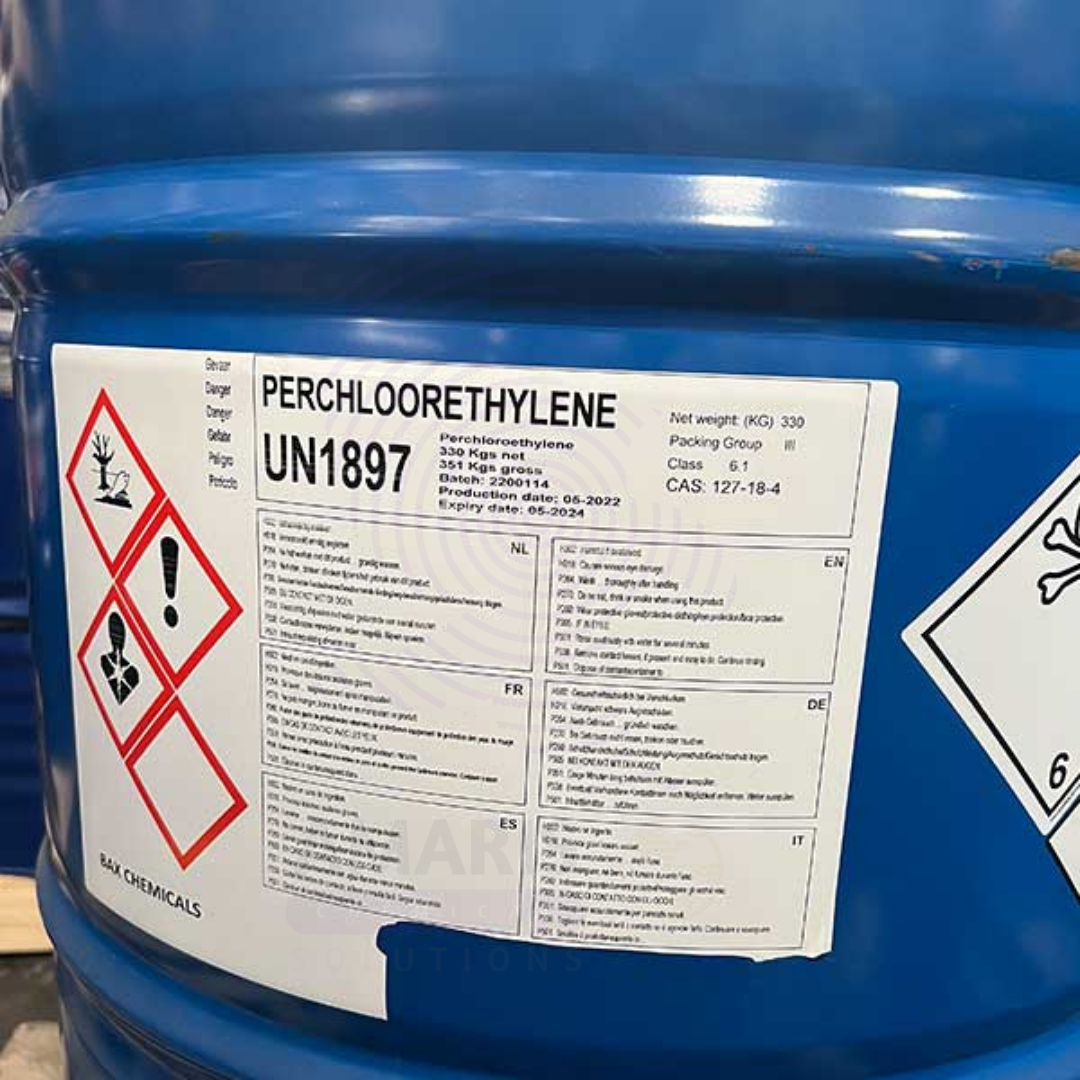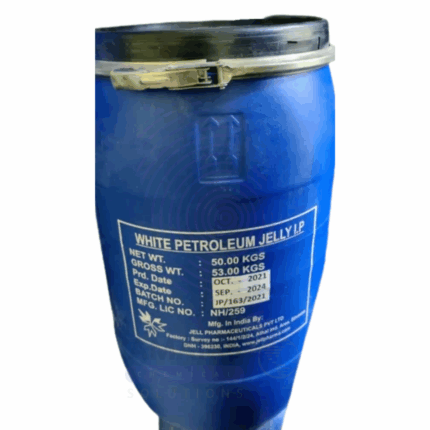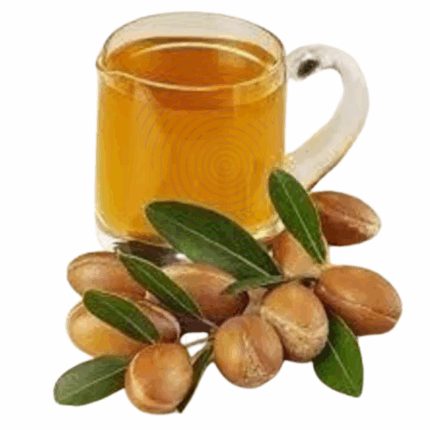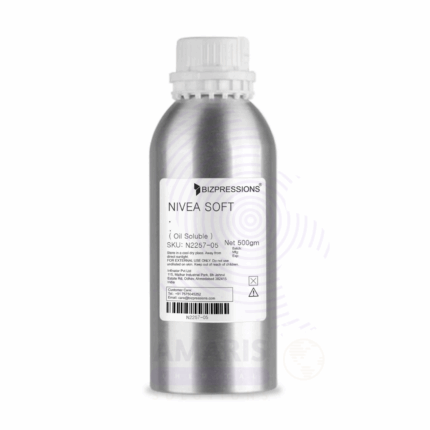Perchloroethylene
Whatsapp Order
Perchloroethylene (also known as tetrachloroethylene or PCE) is a clear, colorless liquid with a sweet odor, widely used as a solvent in dry cleaning and industrial degreasing. It has excellent solvent power for organic materials, is non-flammable, and chemically stable under normal conditions. Perchloroethylene is valued for its efficiency in removing oils, greases, and waxes from fabrics and metals, and serves as a key chemical intermediate in various industrial applications.
Description
Table of Contents
Toggle
Perchloroethylene
Primary Uses
- Dry Cleaning Solvent
- The primary solvent used in commercial dry cleaning for removing oils, stains, and dirt from textiles without damaging the fabric.
- Provides effective cleaning with minimal fabric shrinkage or color loss.
- Industrial Degreasing
- Used to clean metal parts, machinery components, and electronic equipment by dissolving grease, oils, and wax residues.
- Suitable for vapor degreasing and cold cleaning processes.
- Chemical Intermediate
- Employed as a raw material in the manufacture of fluorocarbons and other chemical products.
- Extraction Solvent
- Used in laboratories and industrial processes to extract organic compounds from mixtures.
Secondary Uses
- Adhesive and Coatings Manufacturing
- Utilized as a solvent in adhesive formulations and specialty coatings.
- Textile and Leather Processing
- Applied in cleaning and finishing processes for textiles and leather goods.
- Pesticide Formulations
- Acts as a solvent carrier in certain pesticide products.
- Electronics Industry
- Used for cleaning delicate electronic components during manufacturing.
KEY PRODUCT FEATURES
Key Attributes
Basic Identification Attributes
- Chemical Name (IUPAC): Tetrachloroethylene
- Common/Trade Name: Perchloroethylene, PCE, Tetrachloroethene
- CAS Number: 127-18-4
- HS Code: 2903.39.00
- Synonyms: Perc, Dry cleaning solvent, Tetrachloroethene
Physical & Chemical Properties
- Physical State: Clear, colorless liquid
- Color & Odor: Odorless to sweet aromatic odor
- Boiling Point: 121°C
- Melting Point: -22.8°C
- Density: 1.62 g/cm³ at 20°C
- Solubility: Slightly soluble in water; miscible with most organic solvents
- Vapor Pressure: 18.3 kPa at 25°C
Safety & Hazard Attributes
- GHS Classification: Hazardous (Carcinogenic, harmful if inhaled or swallowed, causes skin and eye irritation)
- Toxicity: Moderate to high toxicity; potential carcinogen (IARC Group 2A)
- Exposure Limits: OSHA PEL - 100 ppm (8-hour TWA)
Storage & Handling Attributes
- Storage Conditions: Store in a cool, well-ventilated area away from heat and ignition sources
- Container Type: Supplied in sealed metal drums or chemical-grade containers
- Shelf Life: Stable for several years if stored properly
- Handling Precautions: Use personal protective equipment; avoid inhalation and prolonged skin contact
Regulatory & Compliance Attributes
- Complies with EPA, OSHA, and REACH regulations
- Listed under various chemical inventories and reporting requirements
- Subject to strict environmental discharge and workplace exposure limits
Environmental & Health Impact
- Biodegradability: Poorly biodegradable; persistent in environment
- Ecotoxicity: Toxic to aquatic life; avoid release into waterways
- Bioaccumulation: Potential for bioaccumulation in aquatic organisms
- Carcinogenicity/Mutagenicity: Classified as a probable human carcinogen (IARC Group 2A)
SAFETY HANDLING PRECAUTIONS
Safety Handling Precautions
- PPE Required: Respirators, gloves, chemical goggles, and protective clothing
- Handling Guidelines: Use in well-ventilated areas or under fume hoods; avoid skin and eye contact
- Storage Measures: Keep containers tightly closed; prevent vapor release
First Aid Measures
- Inhalation: Move to fresh air immediately; seek medical attention if breathing difficulty occurs
- Skin Contact: Wash with soap and water; remove contaminated clothing
- Eye Contact: Rinse thoroughly with water for at least 15 minutes; seek medical attention
- Ingestion: Do not induce vomiting; seek immediate medical help
Firefighting Measures
- Fire Hazards: Non-flammable but decomposes to produce toxic gases under fire conditions
- Extinguishing Media: Use water spray, foam, dry chemical, or CO₂
- Special Precautions: Firefighters must wear self-contained breathing apparatus (SCBA)
Hazardous Combustion Products: Phosgene, hydrogen chloride, carbon monoxide, and other toxic gases
Related products
Methoxy Propanol Glycol Ether
Methoxy Propanol Glycol Ether, commonly known as PM Glycol Ether, is a clear, colorless liquid with a mild ether-like odor. It belongs to the glycol ether family and is widely used as a solvent in coatings, inks, cleaning products, and industrial applications due to its excellent solvency, low volatility, and favorable evaporation rate. PM Glycol Ether is miscible with water and many organic solvents, making it versatile for a broad range of formulations.
Nivea Type Fragrance Oil
Nivea Type Fragrance Oil is a premium-grade aromatic oil formulated to mimic the clean, soft, and classic scent profile associated with Nivea skincare products. This fragrance features a balanced blend of fresh florals, creamy musk, and light powdery undertones that evoke feelings of comfort, care, and softness. It is widely used in cosmetic and personal care formulations, as well as in household products where a gentle, soothing scent is desired. Due to its stability and compatibility, it can be incorporated into a variety of oil-based or water-based systems.
papain
Product Description
Papain is a proteolytic enzyme extracted from the latex of the papaya fruit (Carica papaya). It breaks down proteins into peptides and amino acids, making it widely used in various industries. Papain has excellent catalytic activity and works effectively across a broad pH range, especially in neutral to slightly alkaline conditions. It is valued for its meat tenderizing, digestive aid, and therapeutic properties.Pine Oil
Pine Oil is a powerful, aromatic essential oil obtained through the steam distillation of the needles, twigs, and cones of pine trees, primarily Pinus sylvestris or other Pinus species. It features a sharp, woody, and fresh scent with natural disinfectant and deodorizing properties. Rich in monoterpenes such as alpha-pinene and beta-pinene, Pine Oil is widely utilized in cleaning products, disinfectants, air care, cosmetics, and industrial formulations. It is valued for its antimicrobial, anti-inflammatory, and degreasing capabilities, making it an effective multi-purpose ingredient across various sectors.
Pineapple Enzyme Powder
Pineapple Enzyme Powder is a fine, light-colored powder derived from the fruit and stem of the pineapple (Ananas comosus), containing the proteolytic enzyme bromelain. It is produced via extraction and subsequent drying (usually spray or freeze-drying) to preserve enzymatic activity. Known for its protein-digesting, anti-inflammatory, and exfoliating properties, this enzyme is widely used across food, nutraceutical, cosmetic, and pharmaceutical industries.
Resistance coil
Resistance Oil is a specialized essential oil blend formulated to enhance the body’s natural resilience and vitality. Derived from a carefully selected combination of botanicals known for their adaptogenic, immune-supporting, and energizing properties, this oil is prized for its warm, earthy, and slightly spicy aroma. The blend typically includes oils such as eucalyptus, rosemary, ginger, and frankincense, each contributing bioactive compounds like cineole, camphor, and alpha-pinene that provide antimicrobial, anti-inflammatory, and circulatory benefits. Resistance Oil is widely used in holistic wellness to support immune health, boost physical endurance, and promote mental clarity during periods of stress or seasonal challenges. Its balanced aromatic profile makes it suitable for therapeutic massage, inhalation, and inclusion in personal care formulations.
Shellsol T
Shellsol T is a low aromatic, high-purity petroleum hydrocarbon solvent known for its excellent solvency power and relatively low odor. It is a clear, colorless liquid commonly used in coatings, adhesives, inks, and chemical processing where strong solvency with moderate evaporation rates is needed. Its balanced properties make it suitable for industrial applications requiring controlled drying and good compatibility with various resins and polymers.
Sulphuric Acid 98%
Sulphuric Acid 98% is a dense, highly corrosive, and strong mineral acid widely used as a fundamental chemical reagent and industrial raw material. It serves as a key component in fertilizer production, chemical synthesis, petroleum refining, and many other industrial processes. The 98% concentration is the concentrated, nearly pure form commonly utilized for manufacturing and processing applications demanding high acid strength and purity.


 Preservatives(food)
Preservatives(food) Flavor Enhancers
Flavor Enhancers Acidulants
Acidulants Sweeteners
Sweeteners Antioxidants
Antioxidants Colorants(food)
Colorants(food) Nutraceutical Ingredients (food)
Nutraceutical Ingredients (food) Nutrient Supplements
Nutrient Supplements Emulsifiers
Emulsifiers
 Collectors
Collectors Dust Suppressants
Dust Suppressants Explosives and Blasting Agents
Explosives and Blasting Agents Flocculants and Coagulants
Flocculants and Coagulants Frothers
Frothers Leaching Agents
Leaching Agents pH Modifiers
pH Modifiers Precious Metal Extraction Agents
Precious Metal Extraction Agents
 Antioxidants(plastic)
Antioxidants(plastic) Colorants (Pigments, Dyes)
Colorants (Pigments, Dyes) Fillers and Reinforcements
Fillers and Reinforcements Flame Retardants
Flame Retardants Monomers
Monomers Plasticizers
Plasticizers Polymerization Initiators
Polymerization Initiators Stabilizers (UV, Heat)
Stabilizers (UV, Heat)
 Antifoaming Agents
Antifoaming Agents Chelating Agents
Chelating Agents Coagulants and Flocculants
Coagulants and Flocculants Corrosion Inhibitors
Corrosion Inhibitors Disinfectants and Biocides
Disinfectants and Biocides Oxidizing Agents
Oxidizing Agents pH Adjusters
pH Adjusters Scale Inhibitors( water)
Scale Inhibitors( water)
 Antioxidants(cosmetic)
Antioxidants(cosmetic) Emollients
Emollients Fragrances and Essential Oils
Fragrances and Essential Oils Humectants
Humectants Preservatives
Preservatives Surfactants(cosmetic)
Surfactants(cosmetic) Thickeners
Thickeners UV Filters
UV Filters
 Fertilizers
Fertilizers Soil Conditioners
Soil Conditioners Plant Growth Regulators
Plant Growth Regulators Animal Feed Additives
Animal Feed Additives Biostimulants
Biostimulants Pesticides (Herbicides, Insecticides, Fungicides)
Pesticides (Herbicides, Insecticides, Fungicides)
 Active Pharmaceutical Ingredients (APIs)
Active Pharmaceutical Ingredients (APIs) Excipients
Excipients Solvents(pharmaceutical)
Solvents(pharmaceutical) Antibiotics
Antibiotics Antiseptics and Disinfectants
Antiseptics and Disinfectants Vaccine Adjuvants
Vaccine Adjuvants Nutraceutical Ingredients (pharmaceutical)
Nutraceutical Ingredients (pharmaceutical) Analgesics & Antipyretics
Analgesics & Antipyretics
 Analytical Reagents
Analytical Reagents Solvents(lab)
Solvents(lab) Chromatography Chemicals
Chromatography Chemicals Spectroscopy Reagents
Spectroscopy Reagents microbiology-and-cell-culture-reagents
microbiology-and-cell-culture-reagents Molecular Biology Reagents
Molecular Biology Reagents Biochemical Reagents
Biochemical Reagents Inorganic and Organic Standards
Inorganic and Organic Standards Laboratory Safety Chemicals
Laboratory Safety Chemicals Specialty Laboratory Chemicals(Special Laboratory Equipment)
Specialty Laboratory Chemicals(Special Laboratory Equipment)
 Demulsifiers
Demulsifiers Hydraulic Fracturing Fluids
Hydraulic Fracturing Fluids Scale Inhibitors(oil)
Scale Inhibitors(oil) Surfactants(oil)
Surfactants(oil) Drilling Fluids
Drilling Fluids
 Dyes and Pigments
Dyes and Pigments Bleaching Agents
Bleaching Agents Softening Agents
Softening Agents Finishing Agents
Finishing Agents Antistatic Agents
Antistatic Agents
 Admixtures
Admixtures Waterproofing Agents
Waterproofing Agents Sealants and Adhesives
Sealants and Adhesives Curing Compounds
Curing Compounds Concrete Repair Chemicals
Concrete Repair Chemicals Anti-Corrosion Coatings
Anti-Corrosion Coatings
 Surfactants(cleaning)
Surfactants(cleaning) Builders
Builders Enzymes
Enzymes Solvents (Cleaning)
Solvents (Cleaning) Fragrances
Fragrances
 Electronic Chemicals
Electronic Chemicals Catalysts
Catalysts Lubricants
Lubricants Photographic Chemicals
Photographic Chemicals Refrigerants
Refrigerants Automotive chemicals
Automotive chemicals Pyrotechnic Chemicals
Pyrotechnic Chemicals
 Biodegradable Surfactants
Biodegradable Surfactants Bio-based Solvents
Bio-based Solvents Renewable Polymers
Renewable Polymers Carbon Capture Chemicals
Carbon Capture Chemicals Wastewater Treatment Chemicals
Wastewater Treatment Chemicals
 Pigments
Pigments Solvents(paint)
Solvents(paint) Specialty Coatings
Specialty Coatings Binders/Resins
Binders/Resins Additives
Additives Driers
Driers Anti-Corrosion Agents
Anti-Corrosion Agents Functional Coatings
Functional Coatings Application-Specific Coatings
Application-Specific Coatings
 Fresh Herbs
Fresh Herbs Ground Spices
Ground Spices Whole Spices
Whole Spices Spice Blends
Spice Blends Dried Herbs
Dried Herbs
 Leavening Agents
Leavening Agents Dough Conditioners
Dough Conditioners Flour Treatments
Flour Treatments Fat Replacers
Fat Replacers Decoratives
Decoratives Preservatives(baking)
Preservatives(baking)
 Plasticizers & Softeners
Plasticizers & Softeners Reinforcing Agents
Reinforcing Agents Adhesion Promoters
Adhesion Promoters Vulcanizing Agents
Vulcanizing Agents Antidegradants
Antidegradants Blowing Agents
Blowing Agents Fillers & Extenders
Fillers & Extenders Accelerators & Retarders
Accelerators & Retarders

























